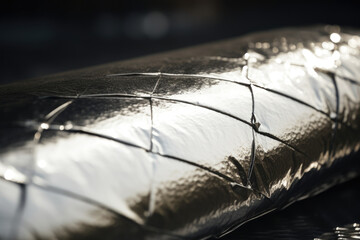Radiant barriers are a great addition to your home’s attic insulation. However, you must ensure they’re installed properly for the best results .During installation, consider any obstacles or features in your attic, such as vents, chimneys, and electrical wiring. Also, check the radiant barrier regularly for signs of sagging or gaps.
The double-sided reflectiveness of radiant barriers makes them a cost-effective energy-saving option for home insulation. They can reduce summer cooling costs by reflecting heat radiation, which prevents it from passing through the air to other surfaces. Radiant barriers are also very durable, making them a good investment for homeowners. However, it’s important to do your research before purchasing any products. There are many options on the market, and prices vary widely. If you can find a good deal, you can save even more money. Visit https://www.ultimateradiantbarrier.com/ to learn more.

While there are many ways to use a radiant barrier in a home, some types are better than others. It’s best to purchase a product that has undergone current ASTM C1313 testing and should be labeled with this information. That will ensure that the radiant barrier will perform as intended.
It is important to know that radiant barriers do not reduce heat transfer through conduction, the process by which thermal insulation materials minimize heating and cooling loss. Instead, they are designed to reflect radiant energy (heat) away from the attic floor and do not reduce convective heat transfer.
That is why radiant barriers are often recommended for homes with vaulted ceilings, which can be challenging to insulate with conventional insulation. A radiant barrier will make the attic floor cooler and can be used with traditional insulation to reduce a home’s energy costs.
Several types of radiant barriers are available, including foil-backed sheathing installed in new construction homes. The sheathing can be draped over rafters, or it can be applied to plywood or OSB sheathing. Installing radiant barriers by spraying them on the attic floor is also possible. While the spray-on products are cheaper, they do not offer the same level of protection as the other types of radiant barriers.
A radiant barrier’s reflective surface redirects heat away from the attic and roof decking, preventing energy loss. This energy-efficient feature saves homeowners money on heating and cooling costs. It also increases a home’s resale value.
Unlike conventional insulation, radiant barriers don’t require convection and condensation to transfer heat. They use radiation to prevent heat transfer, much like a windshield sunshade. That prevents the heat flow that usually carries warm air from the attic into the living space and causes high utility bills.
Radiant barriers are easy to install, and many companies offer DIY kits. However, the installation process requires a ladder and the right tools. Before attempting the job, consult your local building code requirements to ensure you have everything you need to get the job done right. Hiring a professional is recommended to avoid injury and ensure the safety of those involved.
Before you buy a radiant barrier:
- Compare the products on the market to find the best deal.
- Look for a warranty, and ask for current ASTM test results.
- Be wary of companies that claim their product is better than the competition because they may be misleading you with too-good-to-be-true statistics.
Radiant barriers keep homes cool during summer but are less effective during winter. They can reduce the amount of radiant heat that reaches the attic from outside, but they’re unable to stop heat transfer from inside the house to the attic. This product type is best used with other energy-saving measures, such as a new roof and insulation.
Radiant barriers are foil insulation with high reflectivity and low emissivity. They are usually laminated on either side of paper or plastic and come in sheets (sarking) or concertina-type batts. They can be combined with many types of thermal insulation as their facing material. The higher the reflective properties of a radiant barrier, the more heat it will reflect. To ensure you get the best product, look for a radiant barrier with a reflectivity rating of 95-97% and an emissivity of 3-5%.
Radiation barriers are typically built into new homes by having the contractors drape a foil-faced sheathing over joists and trusses during construction. However, they can also be installed in an existing home with an open attic.
When installing a radiant barrier, following the manufacturer’s instructions is important. Hiring a professional with the proper safety gear and who knows how to install the fence correctly is also a good idea. That will ensure that the job is done efficiently and safely.
Once the radiant barrier is installed, it’s essential to inspect it regularly for signs of damage or deterioration. If you notice any problems, it’s best to repair them immediately to prevent energy loss.
A radiant barrier will keep your home cooler and save you money on energy bills. It’s a smart investment for any homeowner but especially useful in warmer climates. The precise savings you will see depend on several factors, including the size of your attic and how well the air ducts are insulated. However, it can catch up to 16% savings in cooling costs with a radiant barrier alone.
Radiant barriers are made of aluminum foil laminated to a substrate material. The materials can range from kraft paper to plastic films, cardboard, or oriented strand board. Some products are also fiber-reinforced for added strength and durability. They can be combined with many types of thermal insulation materials and act as the insulation facing material.
The purpose of radiant barriers is to reduce the amount of heat that transfers in and out of buildings. They do this by reflecting radiant heat, unlike traditional insulation that absorbs it. That is especially useful in warm climates with much higher energy costs during the summer.
Typically, a radiant barrier is installed in the attic of new homes. Contractors drape the rolled-foil product over the attic floor before installing the roof sheathing and then staple it to the rafters. That helps minimize dust accumulation on the reflective surface. Ideally, the product should have an air gap on at least one side to keep it from absorbing radiant heat and converting it into conductive heat.
In addition to reducing cooling costs, radiant barriers can help with winter heating by reflecting radiated heat into the home. They can also prevent moisture transfer in and out of the building. However, radiant barriers should be combined with traditional insulation to achieve maximum benefits.
The lifespan of radiant barriers depends on the conditions in which they are installed and how often they are inspected. They can be expected to last for decades, but regular inspections should be performed to identify potential problems before they become serious. For example, a radiant barrier might begin to break down due to extreme temperatures or moisture.
The use of radiant barriers in homes is one of the most innovative energy-saving technologies available to homeowners. It’s a powerful technology that can significantly reduce heat transfer in and out of your home. However, certain vulnerabilities and issues with radiant barriers are important to be aware of.
A radiant barrier works by reflecting thermal radiation, the energy that makes things hot without contact. That is the same type of heat that you feel on your skin when you walk out on a sunny day and step under a shade tree. Radiant barriers absorb and reflect this energy, which helps to cool the house.
They also help to reduce cooling costs in hot climates. That is because they reduce the heat transferred into the attic, where air conditioning ducts are located. They can sometimes lower your cooling bills by 5% to 25%.
In addition to cooling, radiant barriers can help reduce heating costs in winter. That is because they can reflect the radiant heat from heaters and furnaces into living spaces. However, they are not as effective in lowering heat loss as other types of insulation.
Radiant barriers can be installed in attics in several configurations. The most common is a sheet-type material that is placed directly on the attic floor with its reflective side facing up. Another option is to staple the radiant barrier now to the attic joists or rafter framing. Some manufacturers also sell radiant barrier “chips” blown into the attic, which function as multi-layer, concertina-type products with many trapped air pockets.
